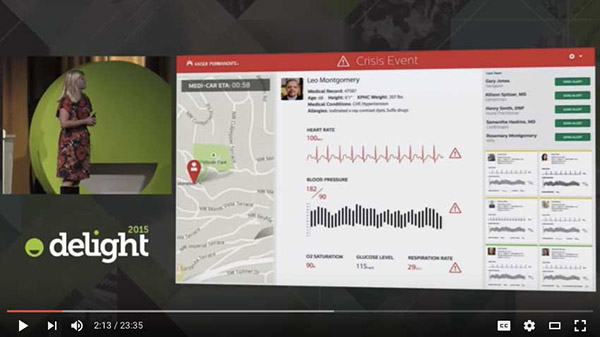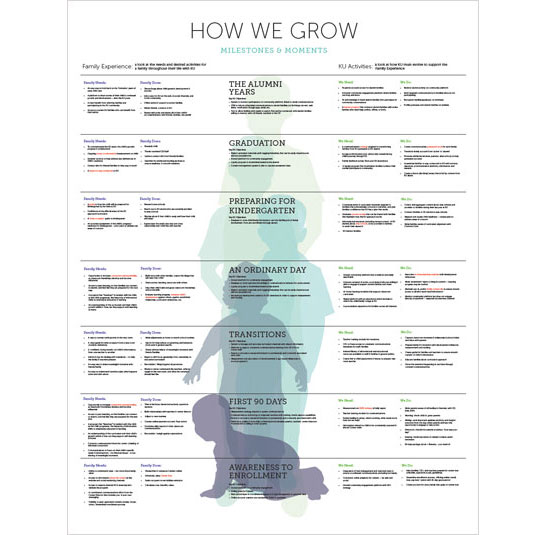POSTED : June 18, 2016
BY : Colin O'Neill
Categories: Customer Engagement,Strategy & Design

A digital experience strategy focuses on creating new areas of value for your business and your customer. Once the strategy is created it’s natural to feel that everyone will immediately see the value and work to execute it. But creating a strategy and communicating it effectively are two different things.
To give your strategy the rollout it requires, you need to go beyond traditional slides and documents and make a purposeful effort to engage people on both a rational and emotional level.
Forrester Research recently published the report A picture’s worth 1,000 CX strategy slides, which highlights how organizations are delivering their digital experience strategy to ensure a shared understanding of the vision. As Deanna Laufer, a senior analyst serving customer experience (CX) professionals, writes in the report:
“Firms build great customer experiences on solid strategies that people sharing a common vision execute. But most companies will find that their employees and executives lack a shared understanding of this vision. And it’s no surprise, given the propensity for dense strategy presentations and graphics that leave audiences befuddled.”
Just as a digital experience strategy focuses on the customer, the delivery of that strategy needs to focus on its customer: the individuals within your organization and their values, beliefs, and attitudes. Because they work within the existing system you need to communicate how this initiative is different. And often the best way to reach them is to tell a story, which starts in a place that’s uncommon for many businesses—the suspension of disbelief.
Once you start telling a story, you change the context of the conversation, free people from the typical way of thinking about the business, and give them an opportunity to create a new mindset. That’s really valuable because there’s typically no shortage of energy and desire for change; it just has no productive outlet.
A well-expressed story gives people a place to put their frustrations and transform them into something constructive. It invites people in and creates space for empathy and imagination. These are critical components of design thinking that become accessible and engaging to everyone.
Your digital experience strategy should describe how the organization can play a positive role in the lives of your customers. But the issue you need to address when delivering the strategy is the opposite: resistance to change. Change is hard, and with a digital experience strategy, it’s important to understand that everybody will experience different kinds of change in different ways.
To counter resistance to change you have to get personal and paint a picture of a future that the individuals want to be part of. Strategy is a “what we can do” conversation, but story is about “what I can be.” It highlights the role of an individual as part of something bigger.
Choosing the right medium to illustrate your story is important. Personas and journey maps hold a lot of valuable information, but they’re design tools. Gantt charts and spider diagrams can hold a lot of valuable data, but they need context. To deliver a strategy that can transform an organization, you need to connect and demand attention.
You want something that represents the seriousness and scale of what is planned but which is also accessible, clear, and shareable. At the 2015 Delight conference, a team from Kaiser Permanente’s Garfield Innovation Center shared their strategic vision for the future of healthcare, Imagining Care Anywhere. They chose to create future state videos they described as “provocations,” which is a great way to think about what you need to deliver:

Selecting the right medium for your digital experience strategy is a matter of understanding your audience, your resources and the impact you need to make. Whether it’s video, audio or printed materials, make sure you create something worth engaging in. Look for things that people have shared, engaged with or commented on. They may have already laid the tracks for the communication you need to create.
As Kaiser’s provocations show, video can be very powerful, but the production value is really important if you want to convince people of the seriousness of the initiative and the level of organizational support. Think creatively about how you use video to inspire people without the need for a Madison Avenue budget.
For the digital experience strategy work we did with our client KinderCare Education (KCE) we created a three-minute video that showed a prototype future state experience in action. But we knew that to gain traction this couldn’t be another “anthem” video from an agency partner. To engage the organization, we needed to empower KCE stakeholders to take ownership of the vision and bring it to life for themselves. So we delivered the final video without a voiceover. Instead, we provided talking points so the clients could tell the story themselves.
Putting clients in the role of storyteller empowers them with the opportunity—and responsibility—of owning and sharing the vision themselves in a personal way. This meant letting go of some of the specifics. But that’s appropriate at this point. Until you get everyone on the same page it can be dangerous to get too specific, because it gives the skeptics a way to challenge or discredit the vision before it takes hold.
When you have established commitment to the vision it’s appropriate to share more specifics. We developed a “growth chart,” a five-foot-tall poster showing how the organization would evolve over the lifetime of one customer.

This made growth feel natural, measurable, and purposeful. It also gave us a way to lay out a long-term vision in an engaging manner that communicated on both an emotional and practical level. When the time is right, sharing the rigor that goes into planning helps build credibility and convince the organization that this is not business as usual.
A customer-centric strategy needs customer-centric delivery. Like any good design project, telling a story starts with understanding your audience, embracing constraints, and clearly defining the required outcome. First, engage the organization in the big picture to ensure understanding and alignment. Then, follow up with compelling details that build credibility and clarity. This last step in your strategy process is the first step toward the delivery. Make sure you deliver something that will live in the imagination and heart of your organization, not locked up in a dry, dusty deck on a shelf.
Learn more about the art and science of customer experiences.
Tags: Strategy